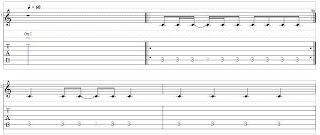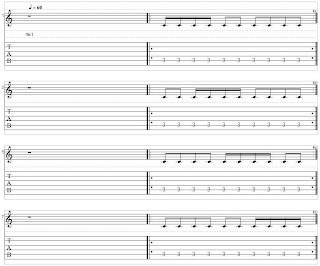One of the things that distinguishes the guitar from most other instruments is that some notes can be found in more than one place on the fretboard. For example, the A note at the 5th fret of your sixth string is the same note as the A when your fifth string is played open. They both have the same pitch or frequency, but they have slightly different timbres due to the physical differences between the fifth string and the sixth string.
The other thing that distinguishes the guitar from most other instruments is all the different ways that a particular note can be played or delivered.
PHRASING
Phrasing is the term that is used to describe the way a particular note has been played or delivered. There are numerous ways to deliver a particular note. Options include:
- fretting the note and just playing it
- sliding into the note from above or below
- hammering-on or pulling off to the note
- bending into the note
Let's look at some of these options, and then apply them to Am Pentatonic Lick #1 from Confession #35 - Repeat & Vary! (Improvisation 1).
HAMMER-ON, PULL-OFF, & SLIDES
Here's a TAB that shows three of the techniques mentioned above:
+-+TAB+1.JPG) |
| Hammer-on, Pull-off, and Slides (Click to Enlarge) |
Hammer-On
The first half of the first measure shows a hammer-on.
Fret the first note (G) with finger 1 and pick the string. Do not pick the second note (A). Instead, bring your 3rd finger down forcefully onto the 10th fret and hold it there (i.e. "hammer" your 3rd finger onto the 10th fret).
Done with sufficient speed and force, the string will continue to vibrate and the A note will sound.
Pull-Off
The second half of the first measure shows a pull-off.
Fret the first note (A) with finger 3, and the second note (G) with finger 1 (i.e. both fingers are on the fretboard at the same time). Now pick the string to sound the A note. Do not pick the second note (G). Instead, tug down slightly with finger 3 as you remove it from the 10th fret.
Done properly, finger 3 will pluck the string and the G note will sound.
Slides
The second measure shows two slides, the first from the G note to the A note, and the second from the A note back to the G note.
Fret the first note with any finger you like. Pick the string to sound the first note. Do not pick the second note. Instead, slide your finger up/down the fretboard to fret the second note.
Done properly, the the string will continue to vibrate from the picked first note and the second note will sound.
If you have a death-grip on the fretboard (see Confession #30 - Lose the Death Grip! ), you're going to find slides difficult. Use a lighter touch and slides will be easier.
ADDING PHRASING to Am PENTATONIC LICK #1
Last week we looked at this lick:
+-+TAB.JPG) |
| Am Pentatonic Lick #1 - No Phrasing (Click to Enlarge) |
It's promising, but I find it sounds a little stiff.
Let's add a little phrasing to this lick, as follows:
 |
| Am Pentatonic Lick #1 - With Phrasing (Click to Enlarge) |
Instead of starting the lick on the A at the 10th fret of the second string, we're going to play what is called a grace note slide. We start on the G at the 8th fret, but slide up the the A on the 10th fret as soon as the string is picked. Its called a grace note because is duration is so short.
The second half of the lick goes from the D at the 10th fret of the first string to the C at the 8th fret. Instead of picking both notes, let's pull off from the D to the C.
Having added only a grace note slide and a pull-off, the lick sounds more loose and more interesting.
Take a look at some of the licks you've created and see if you can apply some phrasing to them to make them sound more interesting!
Video
Next Week's Confession - Play Something, Play Anything!

+-+Fretboard.JPG)



